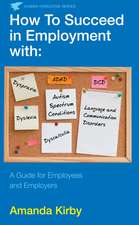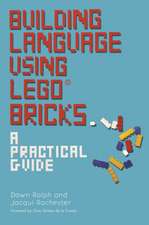Teaching Students With Mental Retardation: A Practical Guide for Every Teacher
Autor Bob Algozzine, James E. Ysseldykeen Limba Engleză Paperback – 22 mai 2006
o Common causes of mental retardation such as genetic conditions, problems during pregnancy and birth, and health problems
o Diagnosing mental retardation
o Cognitive, academic, physical, behavioural, and communication characteristics of mental retardation
o Methods for improving the functional academic, social, self-care, and work skills of students with mental retardation
o Instructional approaches for students with severe disabilities
o Influential trends and issues such as prevention of mental retardation and transitioning from school to work
| Toate formatele și edițiile | Preț | Express |
|---|---|---|
| Paperback (1) | 172.39 lei 3-5 săpt. | |
| SAGE Publications – 22 mai 2006 | 172.39 lei 3-5 săpt. | |
| Hardback (1) | 443.97 lei 6-8 săpt. | |
| SAGE Publications – 22 mai 2006 | 443.97 lei 6-8 săpt. |
Preț: 172.39 lei
Nou
Puncte Express: 259
Preț estimativ în valută:
32.99€ • 34.51$ • 27.40£
32.99€ • 34.51$ • 27.40£
Carte disponibilă
Livrare economică 13-27 martie
Preluare comenzi: 021 569.72.76
Specificații
ISBN-13: 9781412939058
ISBN-10: 1412939054
Pagini: 136
Dimensiuni: 152 x 229 x 9 mm
Greutate: 0.23 kg
Ediția:1
Editura: SAGE Publications
Colecția Corwin
Locul publicării:Thousand Oaks, United States
ISBN-10: 1412939054
Pagini: 136
Dimensiuni: 152 x 229 x 9 mm
Greutate: 0.23 kg
Ediția:1
Editura: SAGE Publications
Colecția Corwin
Locul publicării:Thousand Oaks, United States
Cuprins
About A Practical Approach to Special Education for Every Teacher
Acknowledgements
About the Authors
Self-Assessment I
Introduction to Teaching Students With Mental Retardation
1.What is Mental Retardation?
Definition
Prevalence
2.What Causes Mental Retardation?
Genetic Conditions
Problems During Pregnancy & Birth
Health Problems
3.How is Mental Retardation Diagnosed?
Significance of Adaptive Behavior in Diagnosis
4.What Characteristics Are Associated With Mental Retardation?
Cognitive
Academic
Physical
Behavioral
Communication
5.How Should Teachers Teach Students With Mental Retardation?
Improving Functional Academic Skills
Improving School Adaptive Behavior
Improving Work Skills
Improving Leisure Skills
6.What Should Every Teacher Know About Teaching Students With Severe Disabilities?
Definition
Prevalence
Curriculum Considerations
Instructional Approaches
7.What Trends and Issues Influence How We Teach Students With Mental Retardation?
Prevention of Mental Retardation
Transitioning From School to Work
8.Mental Retardation in Perspective
Recent Advances
The Importance of Environments
Inclusion
9. What Have We Learned?
Key Points
Key Vocabulary
Self-Assessment II
Answer Key for Self-Assessments
On Your Own
Resources
Books
Journals & Articles
Organizations
References
Index
Acknowledgements
About the Authors
Self-Assessment I
Introduction to Teaching Students With Mental Retardation
1.What is Mental Retardation?
Definition
Prevalence
2.What Causes Mental Retardation?
Genetic Conditions
Problems During Pregnancy & Birth
Health Problems
3.How is Mental Retardation Diagnosed?
Significance of Adaptive Behavior in Diagnosis
4.What Characteristics Are Associated With Mental Retardation?
Cognitive
Academic
Physical
Behavioral
Communication
5.How Should Teachers Teach Students With Mental Retardation?
Improving Functional Academic Skills
Improving School Adaptive Behavior
Improving Work Skills
Improving Leisure Skills
6.What Should Every Teacher Know About Teaching Students With Severe Disabilities?
Definition
Prevalence
Curriculum Considerations
Instructional Approaches
7.What Trends and Issues Influence How We Teach Students With Mental Retardation?
Prevention of Mental Retardation
Transitioning From School to Work
8.Mental Retardation in Perspective
Recent Advances
The Importance of Environments
Inclusion
9. What Have We Learned?
Key Points
Key Vocabulary
Self-Assessment II
Answer Key for Self-Assessments
On Your Own
Resources
Books
Journals & Articles
Organizations
References
Index
Notă biografică
Bob Algozzine is a professor in the Department of Educational Leadership at the University of North Carolina and project codirector of the U.S. Department of Education-supported Behavior and Reading Improvement Center. With 25 years of research experience and extensive firsthand knowledge of teaching students classified as seriously emotionally disturbed, Algozzine is a uniquely qualified staff developer, conference speaker, and teacher of behavior management and effective teaching courses. He is active in special education practice as a partner and collaborator with professionals in the Charlotte-Mecklenburg schools in North Carolina and as an editor of several journals focused on special education. Algozzine has written more than 250 manuscripts on special education topics, including many books and textbooks on how to manage emotional and social behavior problems.
Descriere
Learn what effective teachers do to support students with mental retardation in and out of the inclusive classroom!
Providing special and general educators with highly effective strategies for enhancing the academic and social skills of students with mental retardation, and offering a pretest, posttest, and key vocabulary terms, this exceptional resource also discusses:
Providing special and general educators with highly effective strategies for enhancing the academic and social skills of students with mental retardation, and offering a pretest, posttest, and key vocabulary terms, this exceptional resource also discusses:
- Common causes of mental retardation
- Diagnosing mental retardation
- Cognitive, academic, physical, behavioral, and communicational characteristics
- Methods for improving students’ functional academic, social, self-care, and work skills
- Instructional approaches for students with severe disabilities
- Issues such as prevention of mental retardation and transitioning from school to work















